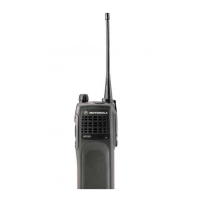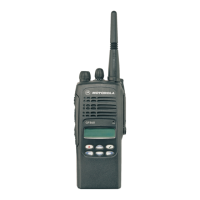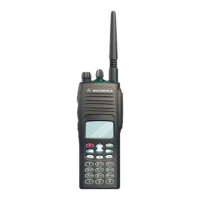
Do you have a question about the Motorola GP300 Series and is the answer not in the manual?
| Frequency Range | VHF: 136-174 MHz, UHF: 403-470 MHz |
|---|---|
| Channel Capacity | 16 channels |
| Power Output | VHF: 1-5 W, UHF: 1-4 W |
| Dimensions | 137 mm x 57.5 mm x 37.5 mm |
| Sealing | Dust and water resistant |
Defines the manual's purpose, target audience, and relevance of information.
Outlines Motorola's product support, including exchange, repair, and parts.
Details warranty terms, product checks before return, and shipping procedures.
Explains post-warranty support options, including repair services and parts availability.
Lists contact numbers for European support centers for repair inquiries.
Information on ordering replacement parts, availability, and serviceability restrictions.
Provides contact information for Motorola's technical support teams across various regions.
Explains how to determine radio model number characteristics like RF output, frequency, and packages.
Discusses intrinsic safety standards, FMRC approval, and labeling for hazardous atmospheres.
Covers responsibilities and procedures for repairing FMRC approved products, including relabeling.
Defines what constitutes a repair for FMRC approved products and where it should be performed.
Outlines procedures and controls for replacing FMRC Approval labels on units.
Emphasizes using only approved system components to maintain intrinsic safety certification.
Introduces the chapter's content on radio maintenance, including inspection, cleaning, and disassembly.
Recommends periodic visual inspection and cleaning for radios, though no scheduled program is required.
Guides on checking external surfaces and controls for cleanliness and functionality.
Details recommended cleaning agents and methods for external and internal radio surfaces.
Provides critical precautions for handling static-sensitive CMOS/LDMOS devices to prevent damage.
Discusses component replacement, substitution guidelines, and soldering techniques.
Outlines general principles and tools required for disassembling and reassembling the radio.
Provides step-by-step instructions for detailed disassembly of radio components.
Details the process of removing the front cover from the radio chassis, including battery removal.
Instructions for disassembling the main board and associated components from the chassis.
Guides on removing keypad, display module, and associated boards from the front cover.
Steps for removing the speaker, microphone, and flex circuit assemblies.
Instructions for disassembling the Push-To-Talk (PTT) bezel and seal.
Details the process of removing the control top assembly, including seals and buttons.
Provides step-by-step instructions for reassembling the radio components after disassembly.
Guides on reinstalling the control top seal, button, and escutcheon.
Instructions for correctly installing the PTT bezel and seal assembly.
Details reassembly of speaker, microphone, and flex circuit components.
Guides on reinstalling the keypad, display module, and associated boards.
Instructions for reassembling the main board and chassis components.
Details the final steps of reassembling the chassis and front cover.
Covers the process of installing option boards into the radio.
Step-by-step guide on configuring the voice storage option board using CPS software.
Provides exploded views and parts lists for various GP300 series radio models.
Exploded mechanical view and parts list for GP320/GP340 models.
Exploded mechanical view and parts list for GP360/GP380 models.
Exploded mechanical view and parts list for the GP330 model.
Lists recommended service aids and tools for working on GP300 series radios.
Lists recommended test equipment required for servicing GP300 series radios.
Details the programming/test cable, its connections, and pin configurations.
Introduces the chapter covering receiver and transmitter performance tests.
Describes the procedures and expected results for receiver performance checks.
Details the procedures and expected results for transmitter performance checks.
Provides an overview of Customer Programming Software (CPS) and tuner programs.
Outlines the setup required for tuning radios using a PC and tuner program.
Lists initial control settings for test equipment used in radio tuning.
Describes the setup for programming radio codeplugs using the CPS software.
Lists models, descriptions, and associated parts for the GP300 Series UHF radios.
Lists models, descriptions, and associated parts for the GP300 Series VHF radios.
Lists models, descriptions, and associated parts for the GP300 Series LB radios.
Lists models, descriptions, and associated parts for the GP300 Series 300R1 radios.
Provides general specifications for GP300 series radios, including channel capacity and dimensions.
Detailed specifications for specific GP300 series models like channel capacity, power, and dimensions.
Explains radio self-test routines, error codes indicated by LED flashes, and their corrections.











